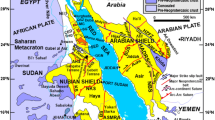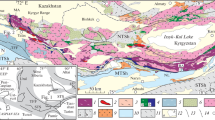Abstract
The Beypazarı granitoid in central Anatolia was emplaced during the Late Cretaceous and it is partly covered with Early Miocene–Quaternary sedimentary and volcanic units. Compression and tension regimes of the Beypazarı granitoid emplacing along the Sakarya River were evaluated considering the kinematical characteristics of discontinuities on granitoids, petrographic/geochemical works, formation of geothermal spring and irregularities in topographic structure. It was determined that the Beypazarı granitoid was witnessed with NE–SW compressional stress and NW–SE extensional stress which resulted in the formation of the Kapullu normal fault with N55–72°E, 78°SE crossing the Kapullu spring site. There are also several other probable normal faults around this fault in the Sakarya River basin. The results of the geochemical studies reveal that SiO2, Na2O, Al2O3, CaO and K2O as a major oxide and As, Rb, Sr, Th and U as trace elements are decreased away from the Kapullu bath spring. On the other hand, the ratio of Fe2O3 and MgO as major oxide and Y as a trace element with the lost on ignition (LOI) are increased away from the Kapullu fault. Regard as the regional plate tectonism, there is a consistency between the direction of compression in the Beypazarı granitoid and that developed by the southwesterly movement of the Anatolian plate.








Similar content being viewed by others
References
Bozkurt E (2001) Neotectonics of Turkey–a synthesis. Geodinamica Acta 14:3–30
Diker S (2005) Hydrogeological investigation of the Kapullu bath (Beypazarı) and around. M.Sc. Thesis, Ankara University, Graduate School of Sciences, pp. 147 (in Turkish)
Diker S, Çelik M, Kadioğlu YK (2005) Formation and hydrogeological characteristics of the Kapullu bath spring (Beypazarı/Ankara). II. National Hydrology Isotope Techniques Symposium, General Directorate of State Hydraulic Works, 26–30 September, Gümüldür/İzmir, pp. 195–208 (in Turkish)
Kadıoglu YK (2004) Nature of Beypazari granitoids: Ankara/Turkey, Geochimica et Cosmochimics Acta 5.5:688
Mohr M (1956) Geological and hydrogeological field study of the Beypazarı region report. General Directorate of Mineral Research and Exploration Collected Report No. 2554, pp 28, Ankara (in Turkish)
MTA (General Directorate of Mineral Research and Exploration) (1963) 1/500,000 scale Zonguldak geological map, Ankara (in Turkish)
Ünal Ü (1997) Mineralogical-petrographical and geochemical investigation of the Beypazarı granitoide (Dümrek-Yalnızçam). M.Sc. Thesis, Hacettepe University, Graduate School of Sciences, pp. 67, Ankara (in Turkish)
Yardley BWD (1989) An introduction to metamorphic petrology. Longman, pp. 248
Yılmaz Y, Şengör AMC (1983) Evolution of tetis in Turkey: an approach by means of plate tectonics, Turkish Geological Society, Geosciences special series No. 1, Ankara (in Turkish)
Yılmazer İ, Yılmazer Ö, Özkök D and Gökçekuş H (1999) Introduction to geotechnical design. Yılmazer Education and Engineering Limited Company, Ankara (in Turkish) pp. 210
Zoroglu O, Kadıoglu YK (2004) Amphiboles as a petrogenetic indicator of granitoid enclaves: Oymaağaç, Turkey. Goldschimidt 2004 Copenhagen, 5.5.55, A674
Acknowledgement
Authors are grateful to Professor Dr. Ilyas Yılmazer for his help in the evaluation of discontinuities measured in granitoids. This study was financially supported by TUBITAK under grand no. 104Y056, DPT 2003-K-120-190-4-1 and Scientific Research Projects Unit of the Ankara University under grand nos. 2003-07-45-015 and 2005-07-45-027.
Author information
Authors and Affiliations
Corresponding author
Rights and permissions
About this article
Cite this article
Diker, S., Çelik, M. & Kadıoğlu, Y.K. Finger prints of the formation of geothermal springs on the granitoids: Beypazarı–Ankara, Turkey. Environ Geol 51, 365–375 (2006). https://doi.org/10.1007/s00254-006-0332-z
Received:
Accepted:
Published:
Issue Date:
DOI: https://doi.org/10.1007/s00254-006-0332-z




